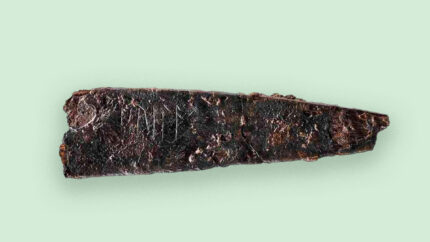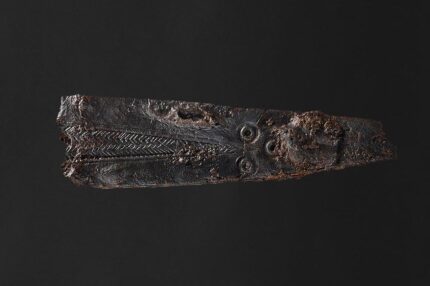 Archaeologists at the Museum Odense have identified Denmark’s oldest runes inscribed on a 1,850-year-old knife blade. The inscription consists of five runes with three depressions that runologists have interpreted as “hirila,” meaning “Little Sword.” The runic script is Proto-Norse, the oldest known runic alphabet, and the context dates the blade to around 150 A.D.
Archaeologists at the Museum Odense have identified Denmark’s oldest runes inscribed on a 1,850-year-old knife blade. The inscription consists of five runes with three depressions that runologists have interpreted as “hirila,” meaning “Little Sword.” The runic script is Proto-Norse, the oldest known runic alphabet, and the context dates the blade to around 150 A.D.
The knife was discovered by Museum Odense archaeologists in a burial ground in Tietgenbyen, east of Odense. It was one of several artifacts in an urn grave. Among the grave goods were three fibulae of a type that was only in use for a very brief period in the mid-2nd century A.D., the Early Roman Iron Age. The knife blade could then be indirectly dated to around the same time.
When the blade was first unearthed, it was coated in a layer of rust that obscured the inscription. Conservators spotted the runes after cleaning the corrosion and contacted National Museum runologist Lisbeth Imer. She examined the blade under a microscope and was able to translate the runic inscription.
Whether hirila is the name of the knife itself, or whether it is the name of the knife’s owner, Museum Odense archaeologists cannot determine with certainty. But there is no doubt that it was a treasured possession that ended up in the grave near Odense almost 2,000 years ago.
Runologist Lisbeth Imer from the National Museum says:
“It is incredibly rare that we find runes that are as old as on this knife, and it is a unique opportunity to learn more about Denmark’s earliest written language and thus also about the language that was actually spoken in the Iron Age. At that time in ancient times, literacy was not particularly widespread, and being able to read and write was therefore associated with a special status and power. At the beginning of the history of the runes, the scribes constituted a small intellectual elite, and the first traces of these people in Denmark are found on Funen.
 Only one other runic inscription from this early period is known. It too was found on Funen less than 10 miles from Tietgenbyen but in 1865. It is a small bone comb inscribed with the runes “harja,” which either means “comb” or is a personal name.
Only one other runic inscription from this early period is known. It too was found on Funen less than 10 miles from Tietgenbyen but in 1865. It is a small bone comb inscribed with the runes “harja,” which either means “comb” or is a personal name.
“Little Sword” will be going on display in a new exhibition at the Museum Odense’s Møntergården museum from February 2nd through April 7th. It will be accompanied by other artifacts recovered from the Iron Age burial ground.
To “Hirila” –as in the northern languages– there are similar words even in Ancient Greek and Old English.
…The Old English one would be “Heoru”, while I am obviously not supposed to post the Greek one: “μάχαιρα”…